Cellular Internalization and Exiting Behavior of Zwitterionic 4-Armed Star-Shaped Polymers
Abstract
1. Introduction
2. Results and Discussion
2.1. Synthesis and Characterization of 4armPMB
2.2. Cytotoxicity of 4armPMB and LinearPMB
2.3. Cellular Uptake of Polymers
3. Materials and Methods
3.1. Materials
3.2. Synthesis of Pentaerythritol Tetrakis(2-bromoisobutyrate) (4f-BiB)
3.3. Synthesis of Polymers
3.4. Evaluation of the Hydrophobic Domain in the Polymer Solution
3.5. Hydrodynamic Diameter of Polymers
3.6. Evaluation of Polymer Chain Mobility
3.7. Observation of Cellular Penetration
3.8. Cytotoxicity Measurement
3.9. Flow Cytometric Analysis of Cellular Uptake
3.10. Statistical Analysis
4. Conclusions
Supplementary Materials
Author Contributions
Funding
Acknowledgments
Conflicts of Interest
References
- Kulkarni, J.A.; Witzigmann, D.; Thomson, S.B.; Chen, S.; Leavitt, B.R.; Cullis, P.R.; van der Meel, R. The current landscape of nucleic acid therapeutics. Nat. Nanotechnol. 2021, 16, 630–643. [Google Scholar] [CrossRef] [PubMed]
- Lee, Y.W.; Luther, D.C.; Goswami, R.; Jeon, T.; Clark, V.; Elia, J.; Gopalakrishnan, S.; Rotello, V.M. Direct cytosolic delivery of proteins through coengineering of proteins and polymeric delivery vehicles. J. Am. Chem. Soc. 2020, 142, 4349–4355. [Google Scholar] [CrossRef]
- Jiang, F.; Doudna, J.A. CRISPR–Cas9 structures and mechanisms. Annu. Rev. Biophys. 2017, 46, 505–529. [Google Scholar] [CrossRef] [PubMed]
- Liu, C.; Zhang, L.; Liu, H.; Cheng, K. Delivery strategies of the CRISPR-Cas9 gene-editing system for therapeutic applications. J. Control. Release 2017, 266, 17–26. [Google Scholar] [CrossRef] [PubMed]
- Pei, D.; Buyanova, M. Overcoming endosomal entrapment in drug delivery. Bioconjug. Chem. 2019, 30, 273–283. [Google Scholar] [CrossRef]
- Stewart, M.P.; Langer, R.; Jensen, K.F. Intracellular delivery by membrane disruption: Mechanisms, strategies, and concepts. Chem. Rev. 2018, 118, 7409–7531. [Google Scholar] [CrossRef]
- Wang, D.; Tai, P.W.L.; Gao, G. Adeno-associated virus vector as a platform for gene therapy delivery. Nat. Rev. Drug Discov. 2019, 18, 358–378. [Google Scholar] [CrossRef]
- Hou, X.; Zaks, T.; Langer, R.; Dong, Y. Lipid nanoparticles for mRNA delivery. Nat. Rev. Mater. 2021, 6, 1078–1094. [Google Scholar] [CrossRef] [PubMed]
- Lee, Y.W.; Luther, D.C.; Kretzmann, J.A.; Burden, A.; Jeon, T.; Zhai, S.; Rotello, V.M. Protein delivery into the cell cytosol using non-viral nanocarriers. Theranostics 2019, 9, 3280–3292. [Google Scholar] [CrossRef]
- Luther, D.C.; Huang, R.; Jeon, T.; Zhang, X.; Lee, Y.W.; Nagaraj, H.; Rotello, V.M. Delivery of drugs, proteins, and nucleic acids using inorganic nanoparticles. Adv. Drug. Deliv. Rev. 2020, 156, 188–213. [Google Scholar] [CrossRef]
- Nayerossadat, N.; Ali, P.; Maedeh, T. Viral and nonviral delivery systems for gene delivery. Adv. Biomed. Res. 2012, 1, 27. [Google Scholar] [CrossRef]
- He, W.; Xing, X.; Wang, X.; Wu, D.; Wu, W.; Guo, J.; Mitragotri, S. Nanocarrier-mediated cytosolic delivery of biopharmaceuticals. Adv. Funct. Mater. 2020, 30, 1910566. [Google Scholar] [CrossRef]
- Wojnilowicz, M.; Glab, A.; Bertucci, A.; Caruso, F.; Cavalieri, F. Super-resolution imaging of proton sponge-triggered rupture of endosomes and cytosolic release of small interfering RNA. ACS Nano 2019, 13, 187–202. [Google Scholar] [CrossRef]
- Yu, H.; Zou, Y.; Wang, Y.; Huang, X.; Huang, G.; Sumer, B.D.; Boothman, D.A.; Gao, J. Overcoming endosomal barrier by amphotericin B-loaded dual pH-responsive PDMA-b-PDPA micelleplexes for siRNA delivery. ACS Nano 2011, 5, 9246–9255. [Google Scholar] [CrossRef] [PubMed]
- Miura, N.; Shaheen, S.M.; Akita, H.; Nakamura, T.; Harashima, H. A KALA-modified lipid nanoparticle containing CpG-free plasmid DNA as a potential DNA vaccine carrier for antigen presentation and as an immune-stimulative adjuvant. Nucleic Acids Res. 2015, 43, 1317–1331. [Google Scholar] [CrossRef] [PubMed]
- Tateshita, N.; Miura, N.; Tanaka, H.; Masuda, T.; Ohtsuki, S.; Tange, K.; Nakai, Y.; Yoshioka, H.; Akita, H. Development of a lipoplex-type mRNA carrier composed of an ionizable lipid with a vitamin E scaffold and the KALA peptide for use as an ex vivo dendritic cell-based cancer vaccine. J. Control. Release 2019, 310, 36–46. [Google Scholar] [CrossRef] [PubMed]
- Carmona-Ribeiro, A.M.; Pérez-Betancourt, Y. Cationic nanostructures for vaccines design. Biomimetics 2020, 5, 32. [Google Scholar] [CrossRef]
- Ishihara, K.; Ueda, T.; Nakabayashi, N. Preparation of phospholipid polymers and their properties as polymer hydrogel membranes. Polym. J. 1990, 22, 355–360. [Google Scholar] [CrossRef]
- Ishihara, K. Revolutionary advances in 2-methacryloyloxyethyl phosphorylcholine polymers as biomaterials. J. Biomed. Mater. Res. A 2019, 107, 933–943. [Google Scholar] [CrossRef]
- Konno, T.; Watanabe, J.; Ishihara, K. Enhanced solubility of paclitaxel using water-soluble and biocompatible 2-methacryloyloxyethyl phosphorylcholine polymers. J. Biomed. Mater. Res. A 2003, 65, 209–214. [Google Scholar] [CrossRef]
- Mu, M.; Konno, T.; Inoue, Y.; Ishihara, K. Solubilization of poorly water-soluble compounds using amphiphilic phospholipid polymers with different molecular architectures. Colloids Surf. B 2017, 158, 249–256. [Google Scholar] [CrossRef] [PubMed]
- Goda, T.; Imaizumi, Y.; Hatano, H.; Matsumoto, A.; Ishihara, K.; Miyahara, Y. Translocation Mechanisms of Cell-Penetrating Polymers Identified by Induced Proton Dynamics. Langmuir 2019, 35, 8167–8173. [Google Scholar] [CrossRef] [PubMed]
- Lin, X.; Konno, T.; Ishihara, K. Cell-Membrane-Permeable and Cytocompatible Phospholipid Polymer Nanoprobes Conjugated with Molecular Beacons. Biomacromolecules 2014, 15, 150–157. [Google Scholar] [CrossRef]
- Patil, R.A.; Aloorkar, N.H.; Kulkarni, A.S.; Ingale, D.J. Star polymers: An overview. Int. J. Pharm. Sci. Nanotechnol. 2012, 5, 1675–1684. [Google Scholar] [CrossRef]
- Gury, L.; Gauthier, M.; Cloitre, M.; Vlassopoulos, D. Colloidal jamming in multiarm star polymer melts. Macromolecules 2019, 52, 4617–4623. [Google Scholar] [CrossRef]
- Wilts, E.M.; Ma, D.; Bai, Y.; Williams, C.B.; Long, T.E. Comparison of linear and 4-arm star poly(vinyl pyrrolidone) for aqueous binder jetting additive manufacturing of personalized dosage tablets. ACS Appl. Mater. Interfaces 2019, 11, 23938–23947. [Google Scholar] [CrossRef] [PubMed]
- Gupta, A.; Andresen, J.L.; Manan, R.S.; Langer, R. Nucleic acid delivery for therapeutic applications. Adv. Drug Deliv. Rev. 2021, 178, 113834. [Google Scholar] [CrossRef]
- Biju, V.; Anas, A.; Akita, H.; Shibu, E.S.; Itoh, T.; Harashima, H.; Ishikawa, M. FRET from quantum dots to photodecompose undesired acceptors and report the condensation and decondensation of plasmid DNA. ACS Nano 2012, 6, 3376–3788. [Google Scholar] [CrossRef]
- Lou, Q.; Shipp, D.A. Recent developments in atom transfer radical polymerization (ATRP): Methods to reduce metal catalyst concentrations. ChemPhysChem 2012, 13, 3257–3261. [Google Scholar] [CrossRef]
- Ishihara, K. Highly lubricated polymer interfaces for advanced artificial hip joints through biomimetic design. Polym. J. 2015, 47, 585–597. [Google Scholar] [CrossRef]
- Nguyen, T.L.; Kawata, Y.; Ishihara, K.; Yusa, S. Synthesis of amphiphilic statistical copolymers bearing methoxyethyl and phosphorylcholine groups and their self-association behavior in water. Polymers 2020, 12, 1808. [Google Scholar] [CrossRef] [PubMed]
- Ishihara, K.; Iwasaki, Y.; Nakabayashi, N. Polymeric lipid nanosphere consisting of water-soluble poly(2-methacryloyloxyethyl phosphorylcholine-co-n-butyl methacrylate). Polym. J. 1999, 31, 1231–1236. [Google Scholar] [CrossRef]
- Morimoto, N.; Takei, R.; Wakamura, M.; Oishi, Y.; Nakayama, M.; Suzuki, M.; Yamamoto, M.; Winnik, F.M. Fast and effective mitochondrial delivery of ω-Rhodamine-B-polysulfobetaine-PEG copolymers. Sci. Rep. 2018, 8, 1128. [Google Scholar] [CrossRef] [PubMed]
- Genc, F.; Temel, G.; Temel, B.A. Single-chain polymeric nanoparticles using 4-armed star copolymers. Polymer 2020, 201, 122659. [Google Scholar] [CrossRef]
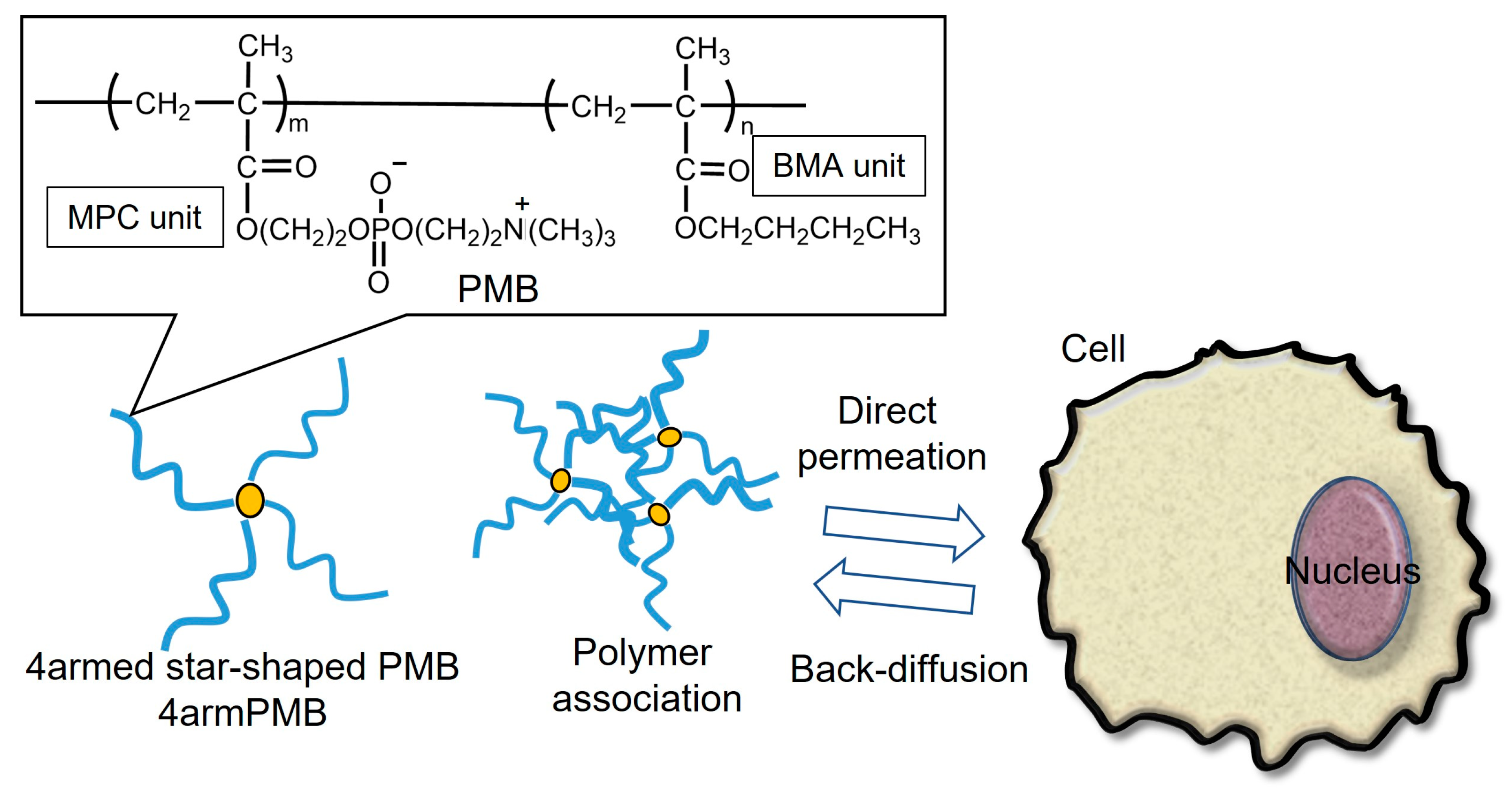
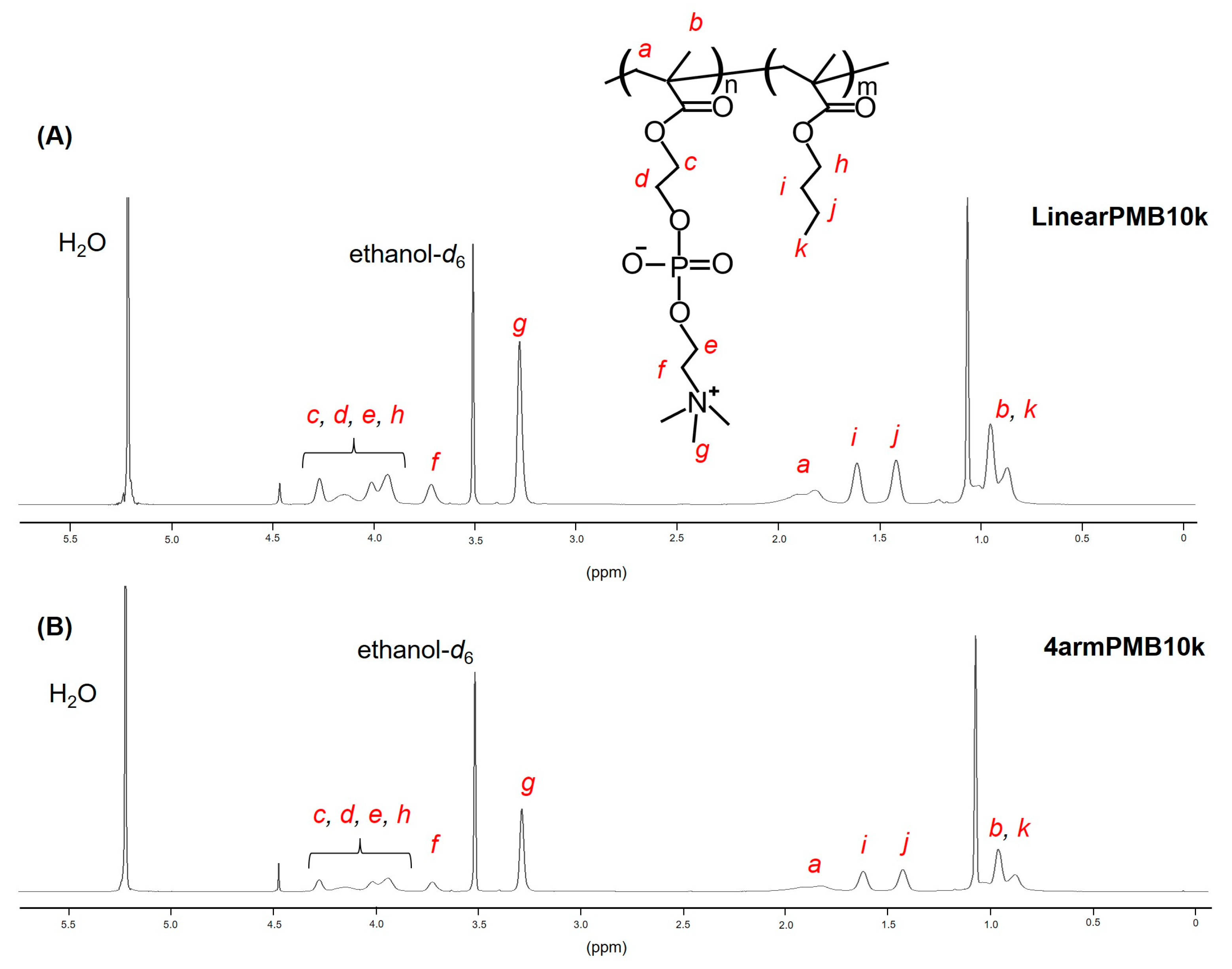

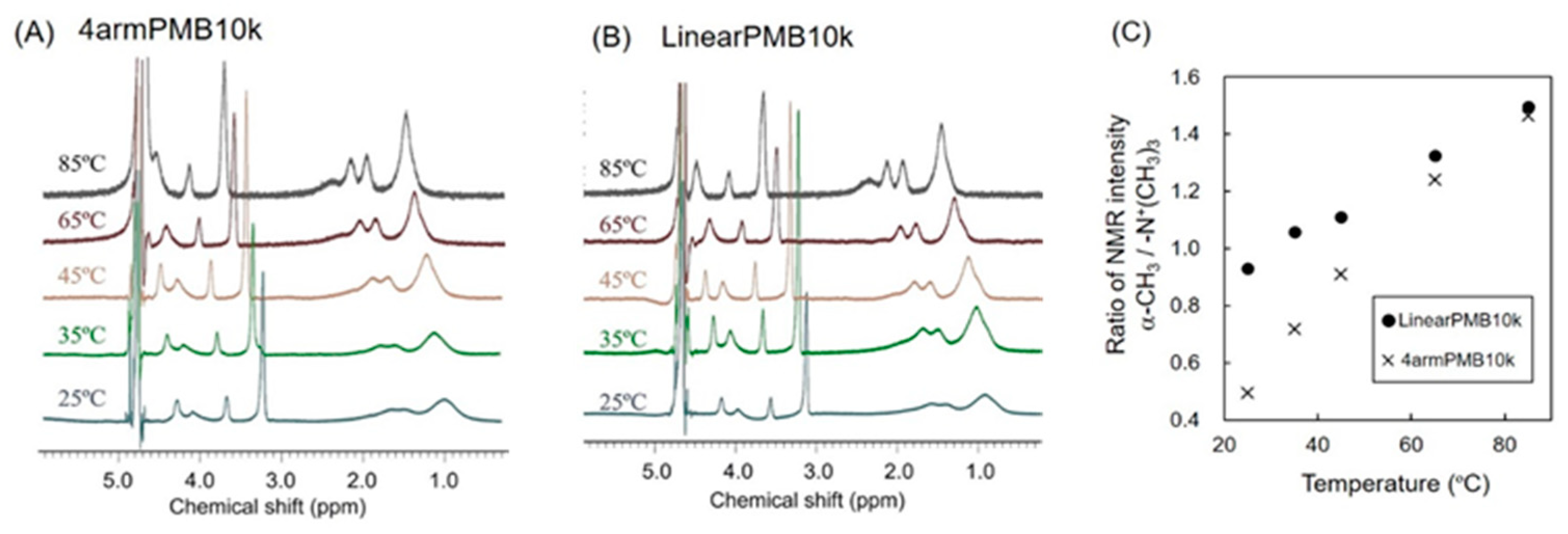
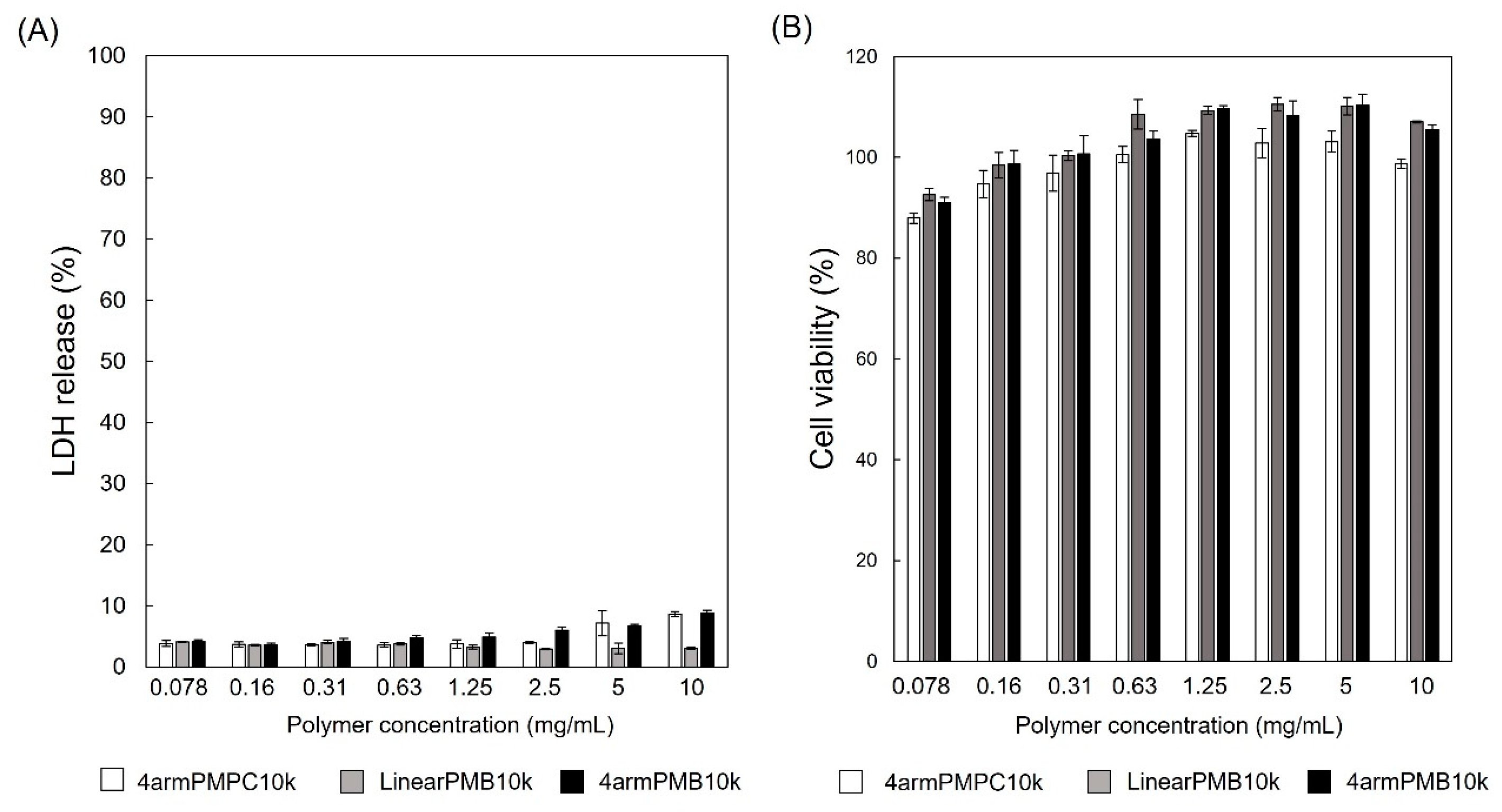
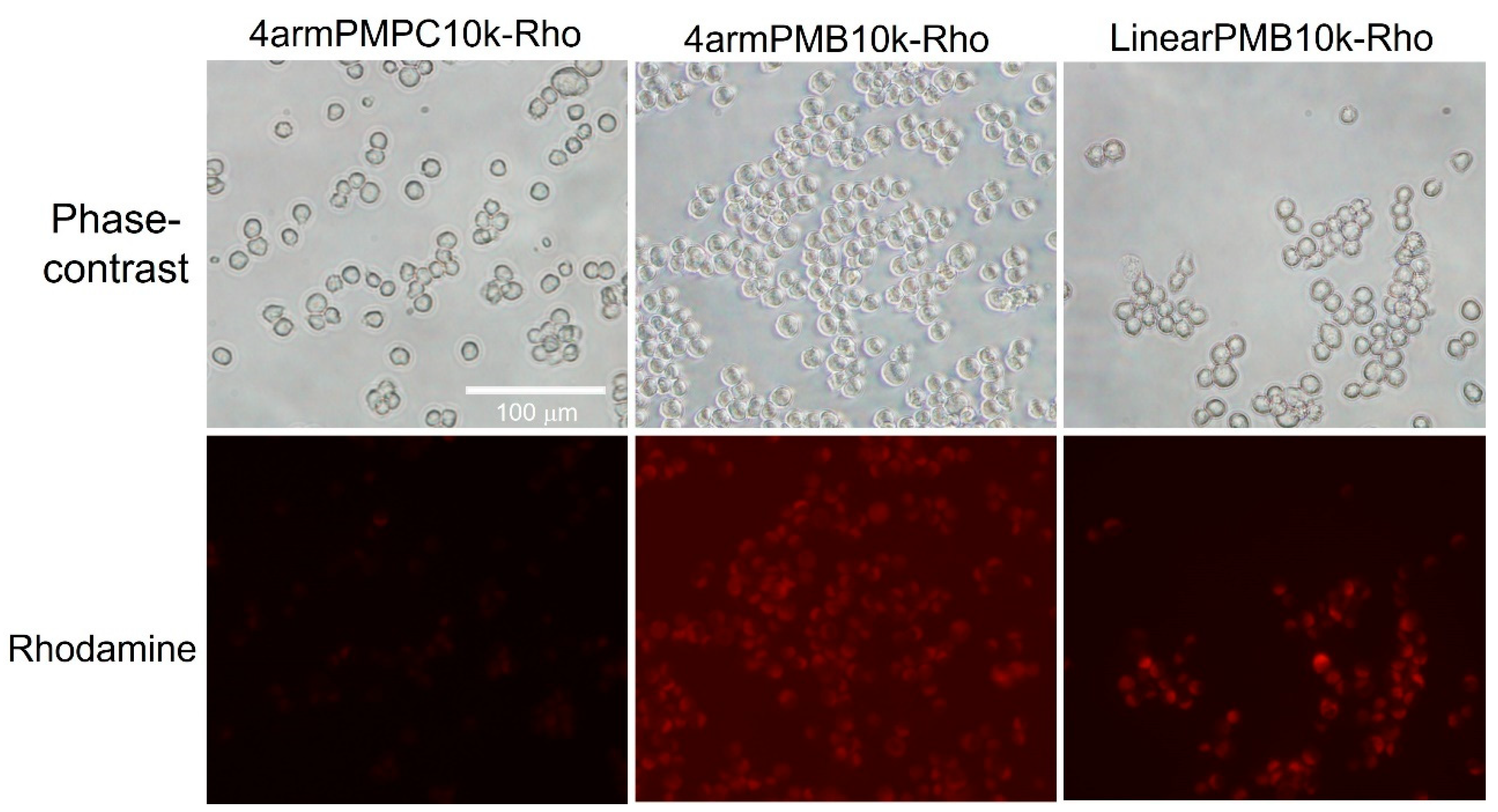


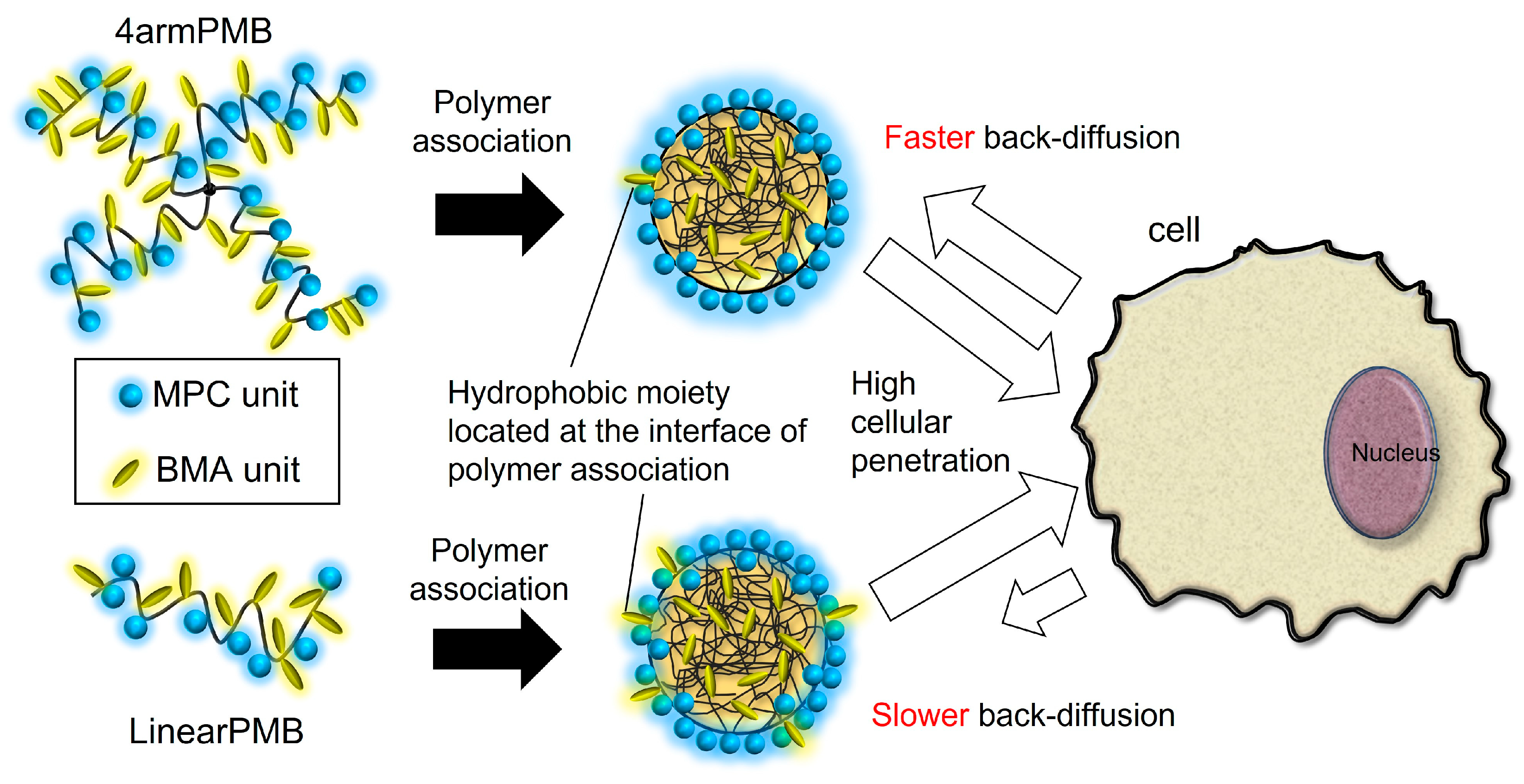
| Abb. | Mw | Mw/Mn (a) | Composition (mol%) (b) | Hydrodynamic Diameter (nm) (c) | ζ-Potential (mV) | |
|---|---|---|---|---|---|---|
| MPC | BMA | |||||
| 4armPMB10k | 14,000 | 1.39 | 30 | 70 | 25 | −2.1 ± 0.5 |
| 4armPMB40k | 37,000 | 2.14 | 30 | 70 | 19 | −8.7 ± 3.1 |
| LinearPMB10k | 5400 | 1.22 | 30 | 70 | 15 | −0.5 ± 0.2 |
| LinearPMB40k | 9600 | 1.55 | 30 | 70 | 14 | −4.7 ± 0.2 |
| 4armPMPC10k | 33,000 | 2.86 | 100 | 0 | 18 (d) | −3.5 (d) |
Disclaimer/Publisher’s Note: The statements, opinions and data contained in all publications are solely those of the individual author(s) and contributor(s) and not of MDPI and/or the editor(s). MDPI and/or the editor(s) disclaim responsibility for any injury to people or property resulting from any ideas, methods, instructions or products referred to in the content. |
© 2023 by the authors. Licensee MDPI, Basel, Switzerland. This article is an open access article distributed under the terms and conditions of the Creative Commons Attribution (CC BY) license (https://creativecommons.org/licenses/by/4.0/).
Share and Cite
Yoshizaki, Y.; Konno, T. Cellular Internalization and Exiting Behavior of Zwitterionic 4-Armed Star-Shaped Polymers. Molecules 2023, 28, 4479. https://doi.org/10.3390/molecules28114479
Yoshizaki Y, Konno T. Cellular Internalization and Exiting Behavior of Zwitterionic 4-Armed Star-Shaped Polymers. Molecules. 2023; 28(11):4479. https://doi.org/10.3390/molecules28114479
Chicago/Turabian StyleYoshizaki, Yuta, and Tomohiro Konno. 2023. "Cellular Internalization and Exiting Behavior of Zwitterionic 4-Armed Star-Shaped Polymers" Molecules 28, no. 11: 4479. https://doi.org/10.3390/molecules28114479
APA StyleYoshizaki, Y., & Konno, T. (2023). Cellular Internalization and Exiting Behavior of Zwitterionic 4-Armed Star-Shaped Polymers. Molecules, 28(11), 4479. https://doi.org/10.3390/molecules28114479






